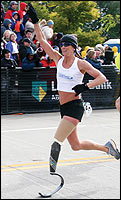Last week a very interesting discussion took place on the Orthopaedics Discussion Group on MyPhysicalTherapySpace.com. The discussion was provoked by the abstract listed after the break, and specifically the following statement:
"The clinical prediction
rule proposed by Childs et al. did not generalise to patients
presenting to primary care with acute low back pain who received a
course of spinal manipulative therapy."
Description of the CPR in question on YouTube
MyPTSpace is a free online community and this debate sure showed how valuable community discussion can be. This conversation was priceless and reminded me of a recent PT Journal Debate between Tim Flynn and Chris Maher, except in more of a WWE RAW style!
Central to the discussion is the question of whether or not the CPR applies to populations outside of those used to develop and study it thus far. Just about all of the authors of the studies up for debate checked in. One important hot topic was the fact that the researchers proposed to study the CPR as "proposed by Childs et al" but only used high-velocity thrust manipulation in a small percentage of patients, as opposed the the 100% utilization in the Childs’ study. This discrepancy provided fuel for the debate as the question was asked, if the researchers applied the rule correctly.
Many chimed in with comments. Most notably, Josh Cleland provided a list of the points he’s pondering:
"I appreciate the dialogue on
this topic. I think we all can appreciate the efforts put forth by both
the Childs team and that of Hancock and colleagues. Certainly I have a
bit of bias here but after critically and objectively analyzing both
articles I walk away with a few thoughts.
1. Perhaps the CPR is only specific to thrust manipulation and not to non-thrust techniques.
2. Perhaps the CPR is only specific to the thrust technique used in the original study and not other thrust techniques.
3. Perhaps the CPR doesn’t apply to patients who are not recruited
from a military setting (we can argue the generalizability of this for
days)
4. Perhaps the exercise used in the Childs study was crucial to success.
5. Perhaps the lack of standardization of techniques is a recipe for failure.
6. The Hancock study does not test the CPR as it was originally developed.
7. Perhaps the rule doesn’t predict response to thrust manipulation
(although the Hancock results to do provide adequate evidence to
suggest this)."
Josh’s summary was generally accepted by all the debaters as a balanced viewpoint. Though there were some other interesting points made as well…
"However, I do find your “more blind faith” comment a bit patronizing and yes, I have read both papers."
"While the scientific method
is intended to provide control, minimize confounding factors, and limit
our biases, we still bring our biases into our scientific endeavors
(including published papers). With this in mind it is helpful to remind
ourselves that clinicians and researchers will generally agree much
better on data than inferences drawn from the data."
"So- evidence exists to
support the use of thrust manipulation in the management of a
particular subgroup of patients. However, therapists in Australia who
are well aware of the evidence fail to use it (even when they were
instructed that they had to use manual therapy). I expect if we gave
therapists control of which techniques to use here in the US we would
see the same magnitude of under utilization."
"…I’m sorry you apparently don’t like chicken sandwiches. 😉 It might just be an American thing…"
"Given you don’t use plain
language words as they are defined in English dictionaries and others
do not use scientific terms as they are defined in scientific texts it
is unlikely we will ever understand each other, let alone reach
agreement."
This was all great fun and if you want to find out who said what in the above statement, go see for yourself. [Link to Discussion]
And here’s one last quote, which I think should be pondered for a while:
"It might just be me, but one
of the reasons I think that the Hancock study has resulted in this
level of discussion is the rather sensational quality of the statements
within the abstract."
I hope you didn’t mind the long post, it was fun for me!
ERIC
(Click on to read the abstract)
Continue reading “MyPhysicalTherapySpace Goes RAW!”





